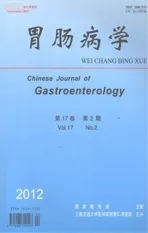感染后肠易激综合征研究现状
2012-03-19侯晓华
宋 军 侯晓华*
华中科技大学同济医学院附属协和医院消化科(430022)
肠易激综合征(irritable bowel syndrome,IBS)是最常见的功能性胃肠病之一,目前其病因和发病机制仍未完全阐明。已有研究证据表明其可能是多种因素共同作用的结果,包括遗传和环境因素、胃肠动力改变、内脏高敏感、肠道感染和炎症、慢性应激、肠道细菌过度生长和脑-肠轴功能紊乱等。部分患者在急性肠道感染恢复后仍存在腹痛、腹部不适、腹泻等症状,即感染后肠易激综合征(postinfectious irritable bowel syndrome,PI-IBS),是近年功能性胃肠病的研究热点。本文就PI-IBS的定义、流行病学、发病机制、动物模型、临床特征、诊断和治疗等相关研究现状作一概述。
一、PI-IBS的定义
PI-IBS是指急性肠道感染恢复后出现符合IBS罗马诊断标准的临床症状[1],而此前无IBS相关临床表现。PI-IBS的诊断仍主要基于症状,具有回顾性特征。急性胃肠道感染的诊断标准为呕吐、腹泻、发热、粪便培养阳性4项指标中至少符合2项,其中胃肠道感染常较快痊愈,因此粪便培养阳性较少见。
二、PI-IBS的流行病学和病因
Stewart等首先发现IBS与肠道感染相关,并认为部分IBS发生于急性肠道感染恢复后。一系列前瞻性和回顾性研究结果均表明,IBS的发生与肠道感染有关。一项欧美研究[2]表明,急性胃肠道感染后3.7%~36%的患者可发生IBS;来自韩国的研究[3]表明,细菌性痢疾恢复后约15%的患者可发生IBS;国内,Wang等[4]的研究结果亦提示,约8.1%的急性细菌性痢疾患者恢复后可进展为IBS。新近,Marshall等[5]发现,急性细菌性痢疾恢复8年后仍有15.4%的患者符合IBS的诊断。
急性肠道感染后发生IBS可能与以下因素有关:①遗传因素:Villani等[6]发现,天然免疫和肠黏膜屏障相关编码基因Toll样受体9(TLR9)、白细胞介素(IL)-6和上皮钙黏素1的基因单核苷酸多态性是PI-IBS的独立危险因素,由此说明PI-IBS具有遗传易感性;②社会-心理因素:心理因素是患者在急性肠道感染恢复后进展为PI-IBS的独立危险因素,尤其是存在疑病症和负性生活事件的患者[7]。其他心理因素如抑郁、神经质等亦可能增加PI-IBS的发病率[8];③病原体:Borgaonkar等[9]发现,空肠弯曲杆菌感染后发生PI-IBS的风险高于沙门菌感染,可能与细菌毒力不同有关;④抗生素的使用:Mearin等[10]发现,17.6%的急性沙门菌肠炎患者在使用抗生素后会进展为PI-IBS,而未使用抗生素者的PIIBS发病率仅为9.3%。Barbara等[11]亦发现,急性肠炎使用抗生素后的IBS样症状明显增加;⑤性别和年龄:研究[12]示女性更易在急性肠炎后进展为PIIBS,且女性患者更易合并焦虑、抑郁等心理问题,但性别因素在PI-IBS发病中的作用尚存在争议。研究[13]发现,年龄超过60岁者的PI-IBS风险低于60岁以下者,可能与老年患者肠道肥大细胞数量减少,免疫反应降低有关。但亦有研究示年龄与PIIBS的发病不相关。
三、PI-IBS的发病机制
PI-IBS患者和动物模型的研究提示,以下机制可能参与PI-IBS的发病:①黏膜损伤和炎症:肠黏膜损伤和低度炎症是PI-IBS突出的病理生理学特点。Troeger等[14]发现,急性肠炎恢复后肠黏膜绒毛面积减少,伴炎症细胞如T淋巴细胞浸润。Spiller等[15]和Gwee等[16]发现,急性肠道感染后出现IBS症状者,直肠活检示炎症细胞数量明显增加。PI-IBS动物模型的研究[17]亦证实,小鼠肠道T淋巴细胞和肠嗜铬细胞数量明显增加,提示肠道感染恢复后仍可能存在持续炎症反应;②肠道通透性增加:Marshall等[18]发现,急性肠道感染后出现IBS症状者的肠道通透性较未发生IBS者明显增加(35%对13%,P=0.03);③肠道菌群紊乱:目前尚无系统性研究支持PI-IBS患者存在肠道菌群紊乱,此推测源于IBS相关研究和动物实验结果;④肥大细胞增生:肥大细胞在PI-IBS和非PI-IBS发病中均起重要作用。Wang等[4]研究发现,急性肠道感染后肠黏膜肥大细胞数量增多,伴细胞脱颗粒增加,推测由其分泌的组胺、5-羟色胺(5-HT)、类胰蛋白酶等,可通过作用于肠道平滑肌和感觉神经元,产生IBS相应临床症状;⑤肠神经可塑性改变:本课题组的前期研究[19]证实,PI-IBS动物模型中支配肠道的内源性神经系统(即肠神经系统,ENS)和外源性神经系统(即自主神经系统,ANS)均存在可塑性改变,其中ENS存在突触超微结构和突触功能蛋白的改变。PI-IBS大鼠和小鼠模型的研究[20~22]均发现,ENS黏膜下和肌间神经丛后超极化神经元和脊髓传入神经、背根神经节等均存在异常电活动,可能与PIIBS内脏高敏感的形成有关;⑥炎症因子的改变:PI-IBS 患者肠道局部和外周血 IL-10、IL-8、IL-6、IL-1 和肿瘤坏死因子(TNF)-α 等明显增加[23];⑦脑-肠轴功能紊乱:研究[24]发现,肠道局部免疫功能紊乱与中枢神经系统的相互作用在IBS症状持续中起重要作用,目前无研究深入探讨脑-肠轴在PI-IBS发病中的作用,但现有研究结果表明PI-IBS存在肠道局部免疫功能紊乱和ENS、ANS异常,提示脑-肠轴功能紊乱可能在其发病中起重要作用。
四、PI-IBS的动物模型
目前用于研究PI-IBS的动物模型主要包括以下两大类[25]:①感染后IBS模型:主要通过寄生虫或细菌感染动物肠道,以模拟PI-IBS急性肠道感染。目前仅一项研究[26]结果表明,大鼠肠道感染空肠弯曲杆菌后可出现与PI-IBS类似的腹泻、大便不成形、小肠细菌过度生长等临床表现,但无内脏高敏感。对PI-IBS寄生虫感染模型的研究较多,主要有旋毛虫、巴西钩虫和小隐孢子虫。目前旋毛虫感染模型应用最广泛,可模拟PI-IBS的内脏高敏感、平滑肌收缩性增加、免疫紊乱等临床特征。②炎症后IBS模型:主要通过化学物质刺激动物肠道以模拟PI-IBS的炎症反应。常用的化学物质包括乙酸、去氧胆酸、糖酐酯、芥子油、酵母聚糖和三硝基苯磺酸(TNBS),通过灌肠或灌胃方式给药,可模拟PIIBS的内脏高敏感、肠道动力紊乱、肠道通透性增加、分泌增加等临床特点,其中以TNBS动物模型应用最广泛。
五、PI-IBS的临床表现和鉴别诊断
临床症状分析示,PI-IBS患者多为腹泻型,可伴腹胀、排便紧迫感和粪便黏液增加。13%为便秘型IBS,24%为混合型[27]。此外,腹胀在PI-IBS患者中亦十分常见。
PI-IBS属排他性诊断,需与乳糖不耐受、胆汁酸吸收不良(表现为夜间腹泻、粪便量增多)、乳糜泻、憩室炎、热带性口炎性腹泻等多种疾病相鉴别。上述疾病亦可继发于急性肠炎恢复后,症状与IBS相似,且易发生重叠,诊断时可通过相关检查进行排除。
六、PI-IBS的治疗和预后
PI-IBS的病因相对明确,但目前无有效治疗方法,本病的治疗目的是缓解症状。临床可根据患者的具体情况使用以下药物:①美沙拉秦:Bafutto等[28]予18例PI-IBS患者和43例腹泻型非PI-IBS患者美沙拉秦800 mg tid治疗30 d,结果示PI-IBS患者的总体症状评分明显下降,排便次数明显减少,粪便黏稠度改善,腹痛和腹胀明显缓解,说明美沙拉秦可明显缓解PI-IBS患者的症状;②新型治疗腹泻型IBS的药物亦可用于治疗PI-IBS,如阿片κ受体激动剂阿西马朵林[29]、活性炭吸附剂AST-120[30]、氯离子分泌抑制剂crofelemer[31]和色氨酸羟化酶1抑制剂LX1031[32]等,均可明显缓解腹泻型IBS患者的症状,改善粪便性状。
PI-IBS患者的临床症状可随时间的延长逐渐缓解,预后明显优于非PI-IBS患者[33]。但亦有研究[5]发现,PI-IBS的症状可持续8年之久。
七、展望
急性肠道感染可致IBS,部分患者在肠道感染痊愈后仍存在IBS症状,即PI-IBS。未来需进一步明确PI-IBS的病理生理学机制和鉴别诊断要点,探索PI-IBS发病中可能的分子机制,从而寻找针对性治疗靶点,以最终治愈PI-IBS。
1 Spiller RC.Postinfectious irritable bowel syndrome[J].Gastroenterology,2003,124(6):1662-1671.
2 SpillerR,Garsed K.Postinfectiousirritable bowel syndrome[J].Gastroenterology,2009,136(6):1979-1988.
3 Ji S,Park H,Lee D,et al.Post-infectious irritable bowel syndrome in patients with Shigella infection[J].J Gastroenterol Hepatol,2005,20(3):381-386.
4 Wang LH,Fang XC,Pan GZ.Bacillary dysentery as a causative factor of irritable bowel syndrome and its pathogenesis[J].Gut,2004,53(8):1096-1101.
5 Marshall JK,Thabane M,Garg AX,et al;Walkerton Health Study Investigators.Eightyearprognosisof postinfectious irritable bowel syndrome following waterborne bacterial dysentery[J].Gut,2010,59(5):605-611.
6 Villani AC,Lemire M,Thabane M,et al.Genetic risk factors forpost-infectious irritable bowelsyndrome following a waterborne outbreak of gastroenteritis[J].Gastroenterology,2010,138(4):1502-1513.
7 GweeKA,Graham JC,McKendrick MW,etal.Psychometric scores and persistence of irritable bowel after infectious diarrhoea[J].Lancet,1996,347(8995):150-153.
8 Spence MJ,Moss-Morris R.The cognitive behavioural modelofirritable bowelsyndrome:a prospective investigation of patients with gastroenteritis[J].Gut,2007,56(8):1066-1071.
9 Borgaonkar MR,Ford DC,Marshall JK,et al.The incidence of irritable bowel syndrome among community subjects with previous acute enteric infection[J].Dig Dis Sci,2006,51(5):1026-1032.
10 Mearin F,Pérez-Oliveras M,Perelló A,et al.Dyspepsia and irritable bowel syndrome after a Salmonella gastroenteritis outbreak:one-year follow-up cohort study[J].Gastroenterology,2005,129(1):98-104.
11 Barbara G,Stanghellini V,Berti-Ceroni C,et al.Role of antibiotic therapy on long-term germ excretion in faeces and digestive symptoms after Salmonella infection[J].Aliment Pharmacol Ther,2000,14(9):1127-1131.
12 Moss-Morris R,Spence M.To"lump"or to"split"the functional somatic syndromes: can infectious and emotional risk factors differentiate between the onset of chronic fatigue syndrome and irritable bowel syndrome[J]?Psychosom Med,2006,68(3):463-469.
13 Neal KR, Hebden J, Spiller R. Prevalence of gastrointestinalsymptomssix monthsafterbacterial gastroenteritis and risk factors for development of the irritable bowel syndrome:postal survey of patients[J].BMJ,1997,314(7083):779-782.
14 TroegerH,LoddenkemperC,SchneiderT,etal.Structural and functional changes of the duodenum in human norovirus infection[J].Gut,2009,58(8):1070-1077.
15 Spiller RC,Jenkins D,Thornley JP,et al.Increased rectal mucosal enteroendocrine cells,T lymphocytes,and increased gut permeability following acute Campylobacter enteritis and in post-dysenteric irritable bowel syndrome[J].Gut,2000,47(6):804-811.
16 Gwee KA,Collins SM,Read NW,et al.Increased rectal mucosal expression of interleukin 1beta in recently acquired post-infectious irritable bowel syndrome[J].Gut,2003,52(4):523-526.
17 Motomura Y,Ghia JE,Wang H,et al.Enterochromaffin cell and 5-hydroxytryptamine responses to the same infectious agentdifferin Th1 and Th2 dominant environments[J].Gut,2008,57(4):475-481.
18 MarshallJK,ThabaneM,GargAX,etal;WEL Investigators.Intestinal permeability in patients with irritable bowel syndrome after a waterborne outbreak of acute gastroenteritis in Walkerton,Ontario[J].Aliment Pharmacol Ther,2004,20(11-12):1317-1322.
19 Yang X,Sheng L,Guan Y,et al.Synaptic plasticity:the new explanation of visceral hypersensitivity in rats with Trichinella spiralis infection[J]?Dig Dis Sci,2009,54(5):937-946.
20 Chen Z,Suntres Z,Palmer J,et al.Cyclic AMP signaling contributes to neural plasticity and hyperexcitability in AH sensory neuronsfollowing intestinalTrichinella spiralis-induced inflammation[J].Int J Parasitol,2007,37(7):743-761.
21 Beyak MJ,Ramji N,Krol KM,et al.Two TTX-resistant Na+ currents in mouse colonic dorsal root ganglia neurons and their role in colitis-induced hyperexcitability[J].Am J Physiol Gastrointest Liver Physiol,2004,287(4):G845-G855.
22 Moore BA,Stewart TM,Hill C,et al.TNBS ileitis evokes hyperexcitability and changes in ionic membrane properties of nociceptive DRG neurons[J].Am J Physiol Gastrointest Liver Physiol,2002,282(6):G1045-G1051.
23 Dinan TG,Quigley EM,Ahmed SM,et al.Hypothalamicpituitary-gut axis dysregulation in irritable bowel syndrome:plasma cytokines as a potential biomarker[J]?Gastroenterology,2006,130(2):304-311.
24 Kraneveld AD,Rijnierse A,Nijkamp FP,et al.Neuroimmune interactions in inflammatory bowel disease and irritable bowel syndrome:future therapeutic targets[J].Eur J Pharmacol,2008,585(2-3):361-374.
25 Qin HY,Wu JC,Tong XD,et al.Systematic review ofanimal models of post-infectious/post-inflammatory irritable bowel syndrome[J].J Gastroenterol,2011,46(2):164-174.
26 Pimentel M,Chatterjee S,Chang C,et al.A new rat model links two contemporary theories in irritable bowel syndrome[J].Dig Dis Sci,2008,53(4):982-989.
27 Dunlop SP,JenkinsD,NealKR,etal.Relative importance of enterochromaffin cell hyperplasia,anxiety,and depression in postinfectious IBS[J].Gastroenterology,2003,125(6):1651-1659.
28 Bafutto M,Almeida JR,Leite NV,et al.Treatment of postinfectious irritable bowel syndrome and noninfective irritable bowel syndrome with mesalazine[J].Arq Gastroenterol,2011,48(1):36-40.
29 Mangel AW,Bornstein JD,Hamm LR,et al.Clinical trial:asimadoline in the treatment of patients with irritable bowel syndrome[J].Aliment Pharmacol Ther,2008,28(2):239-249.
30 Tack JF,Miner PB Jr,Fischer L,et al.Randomised clinical trial:the safety and efficacy of AST-120 in nonconstipating irritable bowel syndrome-a double-blind,placebo-controlled study[J].Aliment Pharmacol Ther,2011,34(8):868-877.
31 Mangel AW,Chaturvedi P.Evaluation of crofelemer in the treatment of diarrhea-predominant irritable bowel syndrome patients[J].Digestion,2008,78(4):180-186.
32 Brown P,Riff DS,Jackson J,et al.LX1031,a novel locally-acting inhibitor of serotonin (5-HT)synthesis significantly improves symptoms in patients with IBS[J].Gastroenterology,2010,138(supplement 5):S129.
33 Neal KR,Barker L,Spiller RC.Prognosis in postinfective irritable bowel syndrome:a six year follow up study[J].Gut,2002,51(3):410-413.
